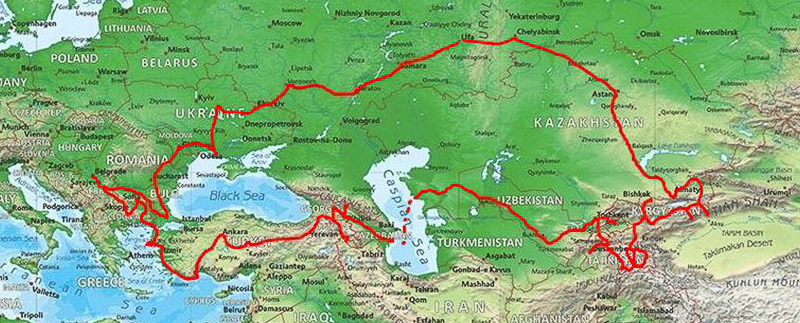

Roughly following one of the Silk routes from western Asia to the Chinese border, I rode through Turkey, Georgia, Armenia, Azerbaijan, Kazakhstan, Uzbekistan, Tajikistan, Kyrgyzstan, Russia, Ukraine, Moldavia, Romania and Bulgaria, visiting historic and natural treasures of the Central Asia. Back in the days, this was a very prosperous region dotted with important cities, some of the worlds largest at the time.
Alexander the Great went deep into this region and left fortresses behind in Uzbekistan. There is a lake named after him in Tajikistan in which he supposedly took a bath before heading to India. Later, Marco Polo came through on his way to China.

Where the heck is Doneristan? It's everywhere in Central Asia.
Turkic people are the dominant ethnicity in Central Asia. Uzbekistan is the cradle of the present-day Turks. The connection is evident in the languages, customs and most notably the food - it's kebabs all the way. So even though I followed the Silk road, I did not go into China, hence the name Kebab route.
Quite appropriately, the best kebab I've eaten anywhere was in Tashkent.
Uzbekistan must have been a true melting pot many centuries ago. I was mesmerized by watching the people - blond Chinese, smooth Caucasians and everything in-between.
Besides historic heritage and ethnic diversity, the region boasts breathtaking scenery. From dry deserts, deep gorges carved by raging rivers to 7,000+ meter high peaks and some of the world's largest glaciers.
I did not plan the route into details. I knew I wanted to ride the Pamir highway and hit some places of historical interest along the way. I chose the southern route (south of the Black sea) because it was the beginning of June and I did not want to deal with cold and rain up north.
After checking out Bulgarian capital and some monasteries and mountains retreats, I passed through Greece and entered Turkey. I roughly followed the Mediterranean coastline of Turkey till Antalya and then headed north to Ankara. There are many archaeological sites in Turkey. I visited only a few of them - Troya, Ephesus, Pergamon and Mt. Nemrut.

Many of the carved rock dwellings were Orthodox churches.

Sunrise balloon ride is a very popular tourist activity in Cappadocia.
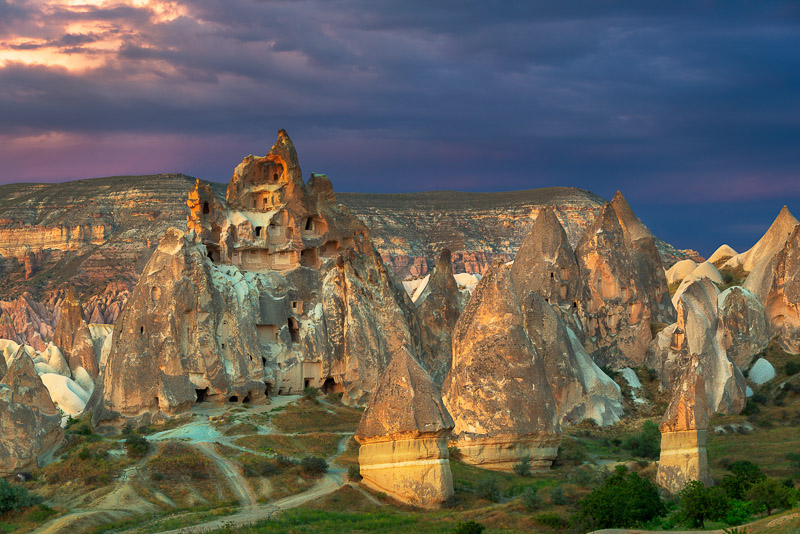
Staying in a "cave hotel" is another Cappadocian must-do.

A fortress city carved out of a giant rock outcrop.

Konya - the spiritual center of the Mevlana order and pilgrimage site.

Bridge over Euphrates.
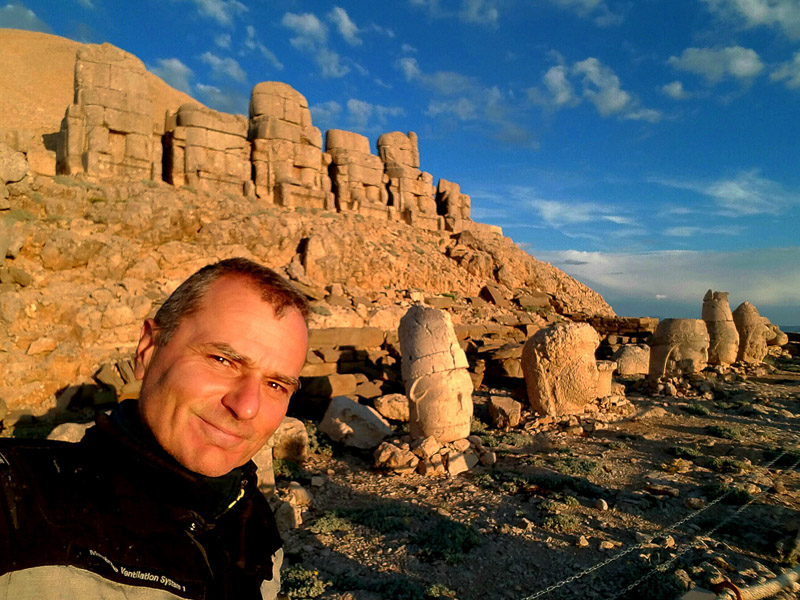
Mt Nemrut - king Antiochus' final resting place.
Uzbekistan visa is still rather complicated to get into, but much easier than it used to be. The approval process takes 7-10 days, but they make it easier by letting you submit application in one city and pick up approved visa in another. So I submitted the application in Ankara and picked up the visa two weeks later in Baku, Azerbaijan.
Consuls in both places were extremely pleasant, helpful and went beyond the call of duty to help tourists.

Medieval fortress near the border with Iran.
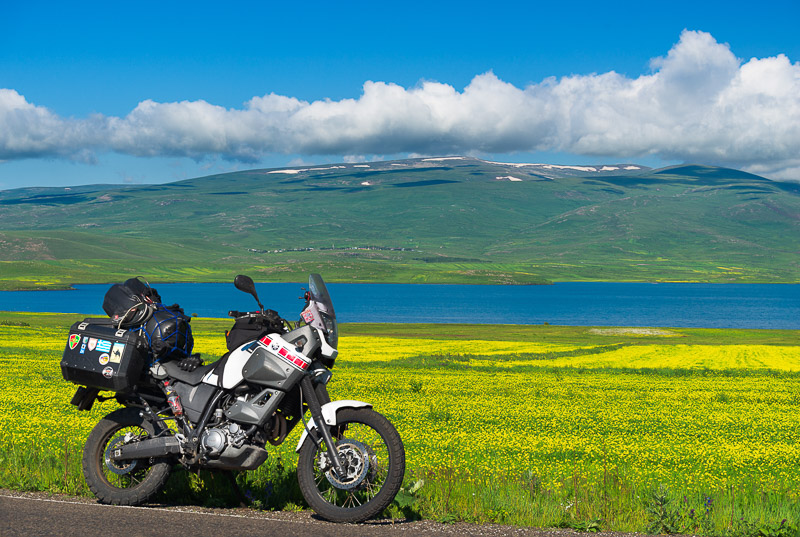
Beautiful morning on the way towards Georgian border.

Riding near the Armenian border.
After Turkey, I rode around Armenia and Georgia before heading into Azerbaijan to pick up my Uzbek visa and get on the ferry across the Caspian sea. In Georgian Caucasus mountains I rode one of the most scenic dirt road I've ever seen. This place is already on the tourist maps as I saw quite a few other travelers heading deep into the Caucasus mountains to enjoy the unspoiled nature.

First signs of the Silk road in Armenia.

Outdoor gallery near the border with Russia.

Unbelieveably green Georgian Caucasus mountains.

Endless switchbacks.
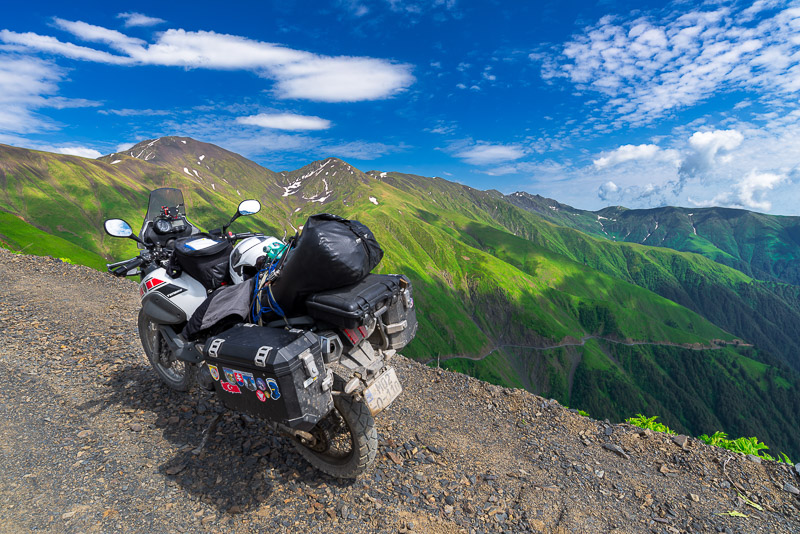
Nearing the top of the pass.

Looking back down the switchbacks.
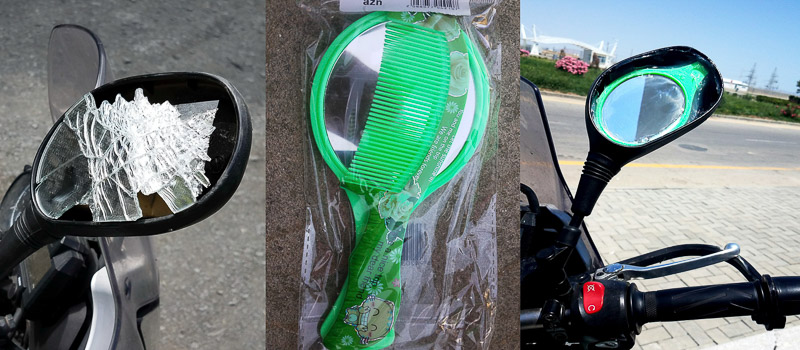
I dropped the bike at one of the switchbacks and broke the mirror. Found replacement in a local beauty shop.
Azerbaijan is blessed with oil and natural gas. Smell of petrol can be felt everywhere. There is even a place where gas seeping out of the ground was set in fire many years ago and still burns.

Gas seeps from the soil and burns and eternal flame.

Baku is a mixture of old and ultra-modern architecture.
After I got my Uzbek visa, I had only one full day in Baku to explore it before I was told that a ferry for Kazakhstan is ready. Caspian sea ferry is one of the bigger uncertainties for travelers who choose this route. There are no fixed departures. The ferry departs when there are enough truck to make it worthwhile for the company. To make things more complicated, they moved both departures and ticket office to Alat, some 60km south of Baku. This makes things particularly inconvenient for bicycle riders. They can't just cycle there, buy a ticket and go back to Baku. They typically camp by the ticket office (and there are hardly any facilities there).

Ferry prices.

Phone number to call to inquire about the next ferry departure.
I was lucky enough that the information I got over the phone was correct. I had to be there before 10 AM to secure the ticket. Two riders arrived little after 10 AM and they couldn't get on the same ferry even though ferry wasn't going to leave till evening. They must have some cut-off time.
I got to know two Bulgarian riders who were going in the same direction - Pamir Highway. Cabin AC was broken and we couldn't spend more than 2-3 min in the steamy cabin. Most people slept on the upper deck under the starry sky. After about 24 hours on the sea, we arrived into the Aktau port around 8 pm. We have all heard of how excruciatingly slow immigration and customs at this port are. So, we were prepared for it. It took them 7 hours to process 7 vehicles. Quite an experience.

Caspian sunset, aboard a ferry to Kazakhstan.

Double-hump camels typical of Central Asia freely roaming through the Kazakh desert.
After one day or relaxing in Aktau, it was 500km of desert before Bulgarian riders and I reached Uzbek border. Border formalities were much more streamlined here and we were in a basic hotel room before sunset. .
Another long day of riding got us to dried up Aral sea. This ecological disaster has become a tourist attraction, a must stop on the route to Khiva. .

Ship graveyard at dried up Aral sea.

Khiva, one of several major cities of the Silk route.
Silk route's great cities of Khiva, Bukhara and Samarkand are biggest draw for tourists from all over the world. Samarkand at the its most prosperous time was one of the largest and most important cities of the world.
While the glorious times of this region are long gone, melons and kebabs are still world's best without doubt.

Khiva.

Khiva madrassa.
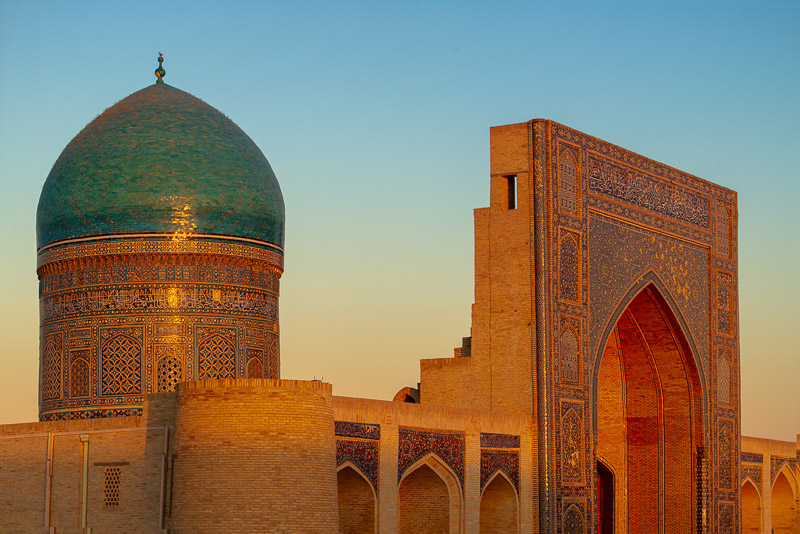
Bukhara.

An unusual mosque in Bukhara.
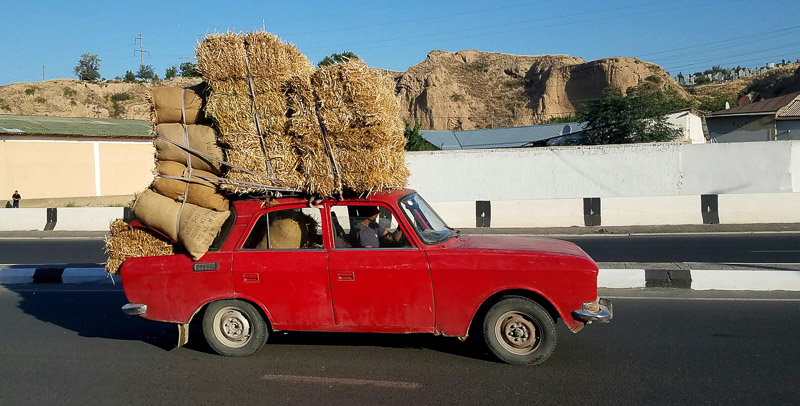
Who needs a pick-up truck when you have Lada.
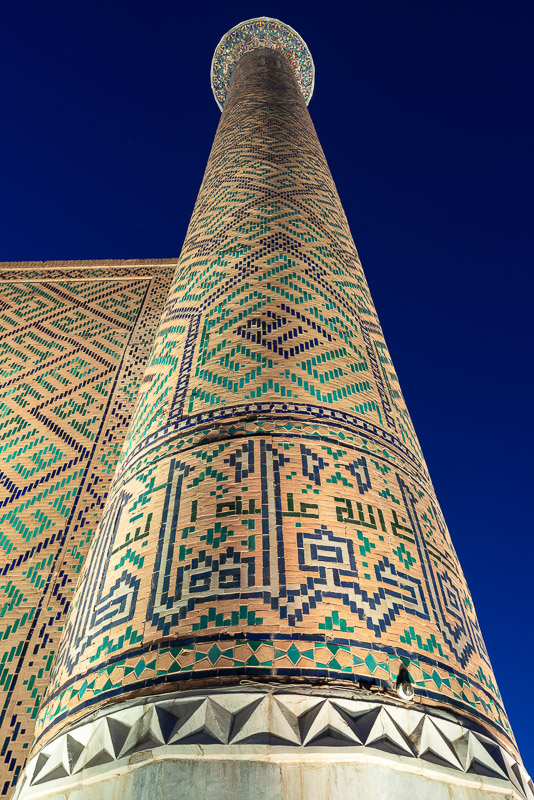
Samarkand minaret.

Samarkand central mosque complex at dusk.

Samarkand.
Tashkent is a big city, one of the biggest even in the former USSR. There are great restaurants and near and colorful markets everywhere. I spent a few extra days there waiting for a new set of tires to arrive from Almaty. I spent two days going up a very scenic valley towards the Kyrgyz border. It was a nice change of scenery after several thousand kilometers of hot desert.

Spices at a Tashkent market - the secret to great kebabs.
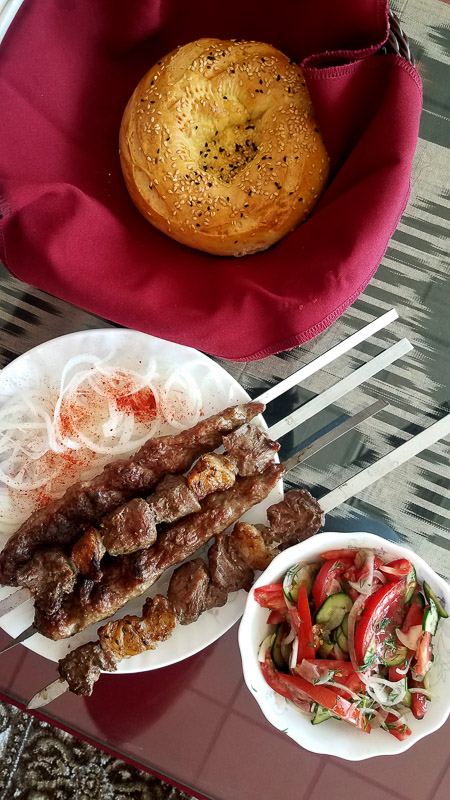
Tashkent kebab - the best one I've eaten.

Dead-end dirt roads towards Kyrgyz border - a perfect spot to drop the bike.
The real mountains were awaiting me in Tajikistan. I had to cross two mountain ranges before reaching Dushanbe, Tajikistan's capital. The main highway goes through tunnels, but I chose to take old, abandoned roads going over high passes instead. I would recommend the same to anyone who is not in a rush. The scenery was breathtaking and traffic very light. Old Anzob pass is actually impassable to any vehicle bigger than a motorcycle due to rockfalls.

This lonesome pass was a great introduction to Tajik mountains.
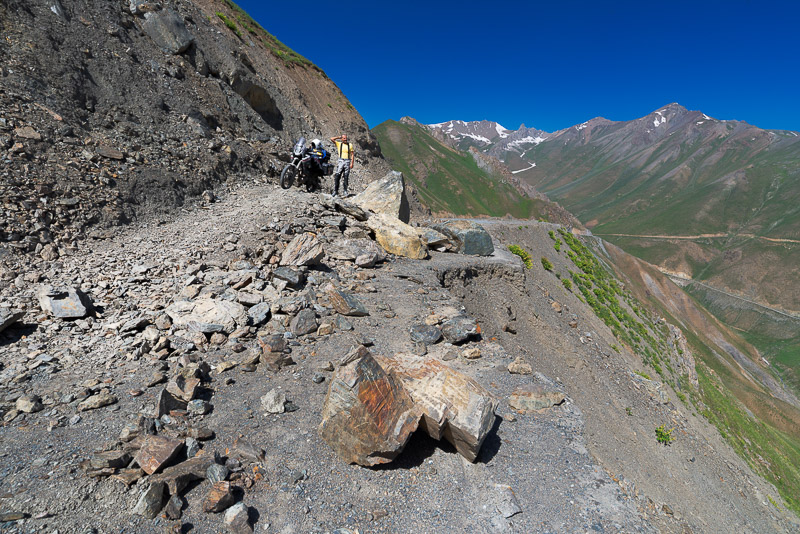
(In)famous Anzob pass was more challenging and is impassable for 4-wheel vehicles.
I had new, more dirt oriented tires put on the bike in Dushanbe since I was planning on riding some more demanding roads in Bartang valley and Zorkul lake. I was glad I spent money on these tires as there were some tough creek crossings.
The main Pamir highway is very scenic and full of tourists on bicycles, motorcycles, cars, jeeps and overland trucks. I never thought this remote place was so popular.

First flat of the trip, at a military check point along the Pamir highway. I was lucky to get flat there as one soldier came and helped me dismount the tight new tire i had put two days earlier in Dushanbe.
Bartang valley and Zorkul lake were blissfully devoid of tourists. In four days I spent on these roads, I ran into only 3 other tourists on their bicycles. Most of the time, I was the only person for miles around. Bartang valley ride was the highlight of my 25,000 km trip.
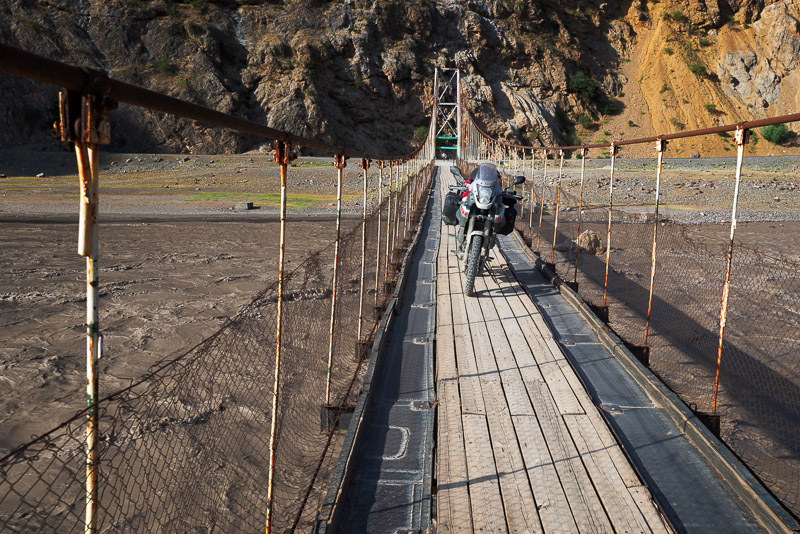
A rather long suspension bridge, for cars (and maybe trucks).

Soda bottles are great for carrying extra fuel. I used up all the extra fuel I brought with me for Bartang valley.
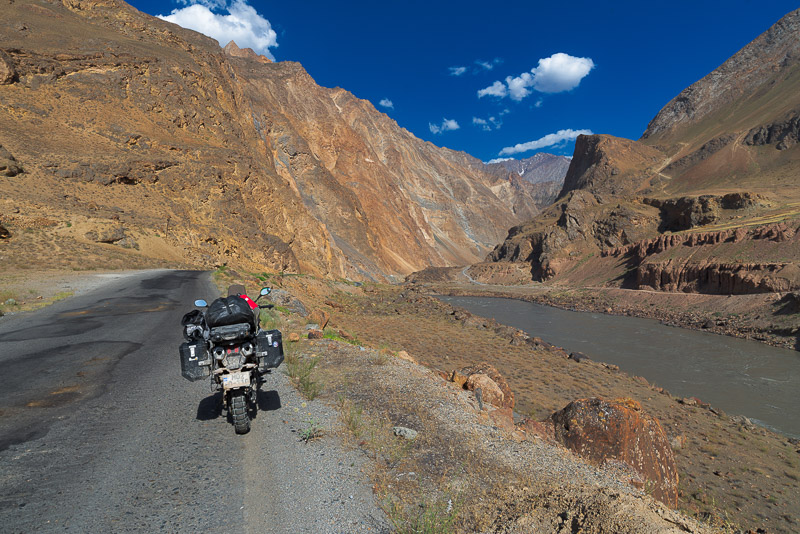
The road through most of Bartang valley is well-maintained.

It may not inspire confidence, but the bridge was solid.

Things happen.
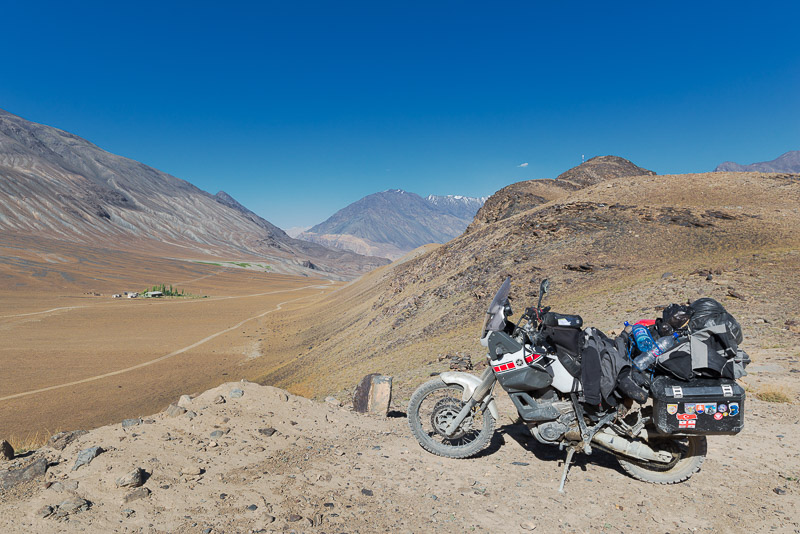
Deep inside Bartang valley.
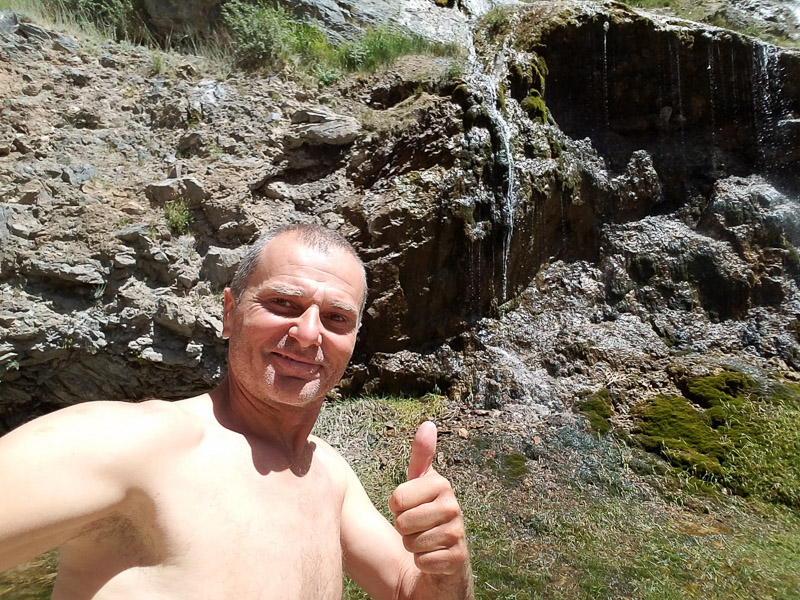
I took a shower under this waterfall in Bartang valley.
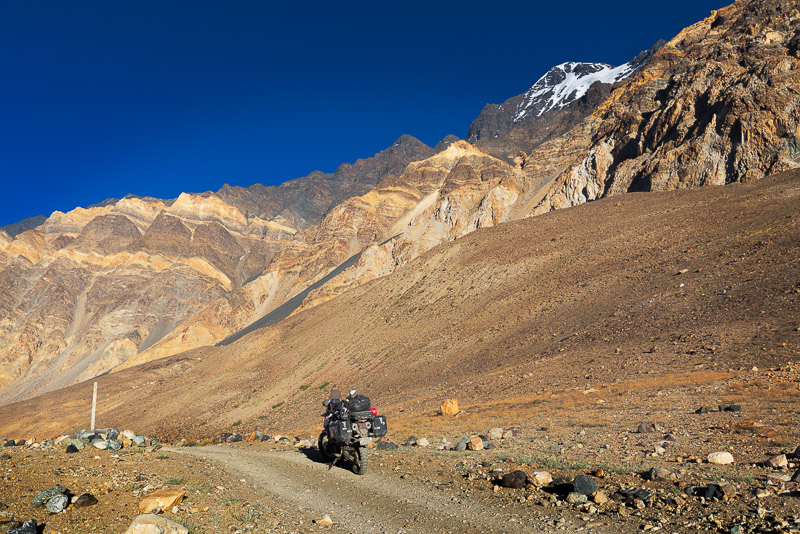
Upper reaches of the valley.

This landslide made the road impassable for any vehicle bigger than a motorcycle.

Apart from a few landslides and gushing creek crossings, the road is in a good condition.

This creek crossing got my attention. There were fairly big submerged rocks and I had to take off all of my luggage. Dropping the bike in the ice-cold creek was not an option here. There was no traffic on this section of the road because of the landslide.

A jumbo-jet could easily land in this part of the valley.

All the rattling took its toll - repairs can't wait any longer.
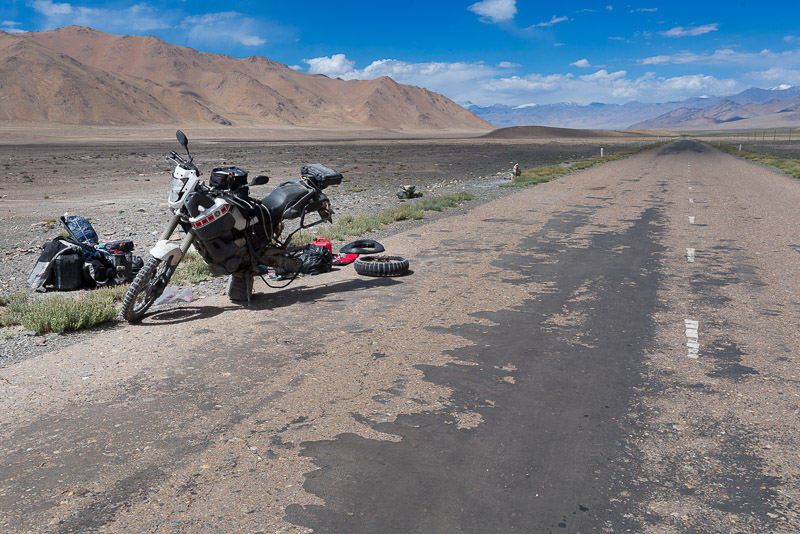
Pamir tire shop - second flat in two days.
Once I fixed the flat, it was already late in the day and I just wanted a shower and bed. I headed back towards Ak-Baital pass towards Khorog, but got only as far as Murghab - a few houses scattered around a dusty, high altitude valley. The hotel was total dump, but that was the only place where I could hide from the bitter cold night temperatures.

Near the top of Ak-Baital, the highest pass on Pamir highway.
Ride through Bartang Valley was one of the four most memorable rides I have ever done.
Khorog is Pamir highway's congregation city with Pamir Lodge being the premier resting spot for most travelers, be it on bicycles, motorcycles or with cars and trucks. This is the place to pick up permits for Zorkul lake and load up on provisions as this is really the last city for travelers heading NE into Kyrgyzstan.
From Khorog, there are two routes heading NE. One is the traditional Pamir highway and the other is Wakhan valley running along the border with Afghanistan. Having ridden the Pamir highway into Khorog, I rode through Wakhan valley to get to Zorkul lake. The road to Zorkul lake runs along ever smaller creek marking the border between Tajikistan and Afghanistan. There were hardly any people on the road. In two days, I saw only 2 bicycling parties and 2-3 jeeps with tourists. East of Zorkul lake, there is a hot spring, another must stop for travelers.

Road to Zorkul lake.

The other side of this ankle-deep creek is Afghanistan.

Snow-covered mountains of Afghanistan.

Camping at no-man's land between Tajikistan and Kyrgyzstan.

Peak Lenin, not far from the border crossing.
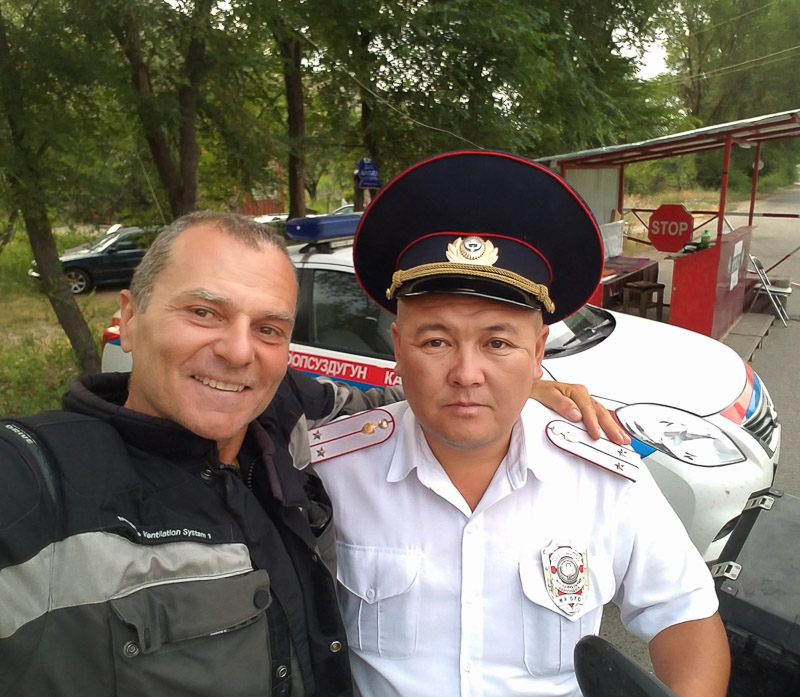
The good cop. Speed limits are low, distances big and police is everywhere. A few kilometers after I got a ticket and neogtiated the price down to 20 from 100 USD, I came across this officer. He stopped me just to check out my bike and talk to me. When he asked me how I like Kyrgyzstan, I told him I loved the country, but wasn't impressed with all the speed traps. I also told him that the cop earlier initially asked for 100 USD. He got upset and started calling around and eventually got hold of the cop who tried to fleece me and reproached him.
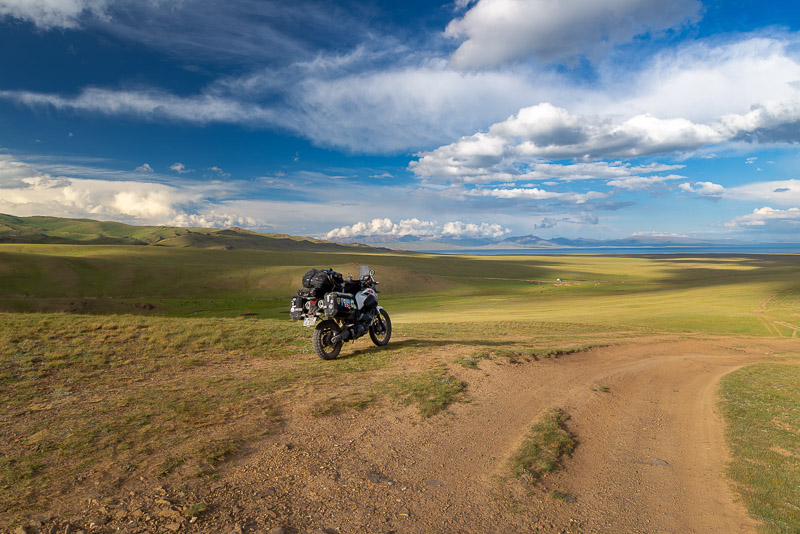
Endless pastures surrounding Songkul lake.

The kid came over to invite me to spend a night in their yurt.
Staying in a yurt is another item every traveler has to "check off." I stayed with a family near lake Songkul, at 4,000 m and the overnight temperatures were below freezing. They spend summers high up and winters (little) lower down. So they are in the cold year round. In the yurt, there is no toilet or running water, but it is pleasantly warm even when it's very cold outside.
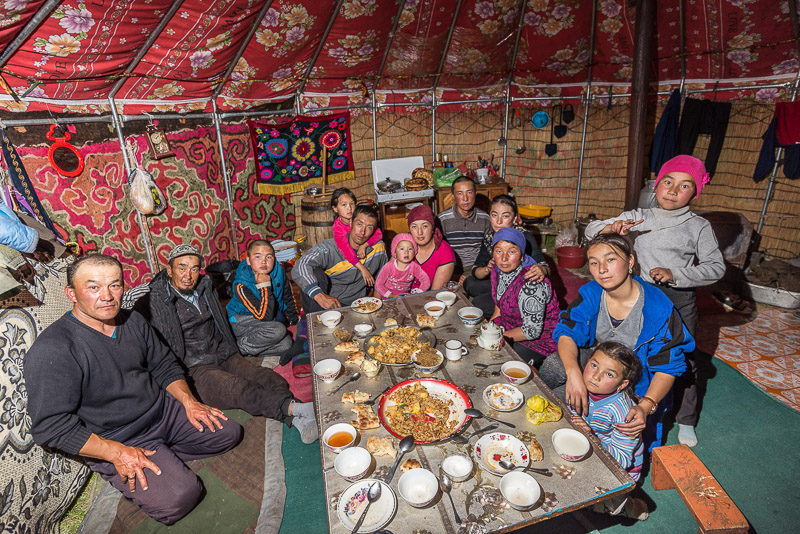
The family spends summers in the yurt and winters lower down in a village.

"Back-side" road to Issyk-kul.

Central Asia's snacks - nuts and dried fruits.

Horse and camel milk on sale in local stores.

And my favorite - Black Russian. Available everywhere.
The most spectacular part of Tian Shan mountains is along the border with China (and Tajikistan to a certain extent). Glacier-capped peaks mark the border. Getting close to the border requires special permits which can be obtained in Karakol (and probably Bishkek), but take money and time (more than a week, even though for a price, things can be sped up).

"Endless sky of a high plateau in Tian Shan mountains.

"Beautiful, desolate roads towards Chinese border.
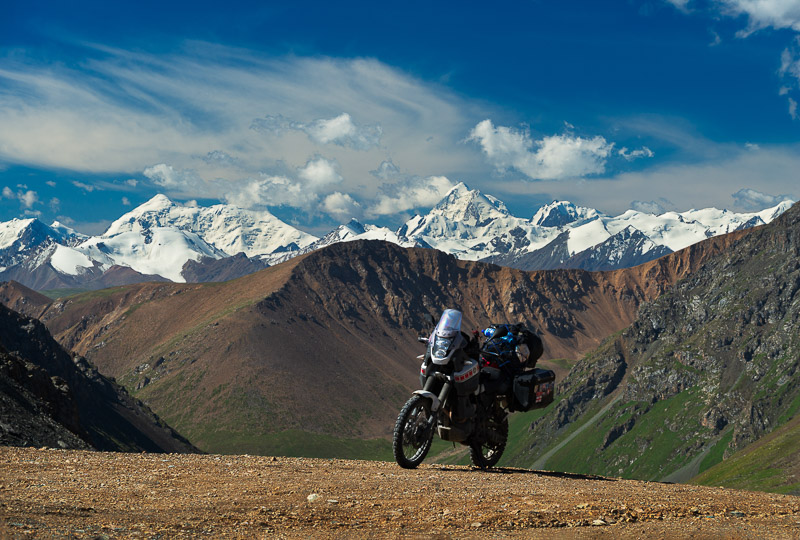
7000+ m peaks mark the border between China and Kyrgyzstan.
Two months into my trip, near the eastern border of Kyrgyzstan with Kazakhstan, I had to turn west-ward and start long journey back home. I crossed back into Kazakhstan near Charin canyon and headed to Almaty. Almaty is a big, modern city with all convenience. Desolate Pamir highway and Murghab seemed so far away, distance- and time-wise. Ahead, 2,000 km of Kazakh prairie were waiting for me before I could check out Astana, Kazakhstan's new capital.

Double rainbow along the 2000 km road between Almaty and Astana.

I was treated by this spectacular sunset near Astana.
After Astana, it was a long day or riding before I reached Russian border. I had to cross Ural mountains on the way west. While not particularly high, it was rather cold riding though those mountains. I visited big cities - Ufa, Samara, Saratov and Voronezh on the way to Ukraine border. Apart from the cities, it was rather boring several thousand kilometers of riding through endless sunflower fields.

At the outskirts of a Russian helicopter base.

A Russian church in Saratov, the place where Gagarin learned to fly.
Ukraine was just as flat as Russia with some sections of REALLY bad roads. However, visiting a decommissioned ballistic missile command center and Black sea resort city of Odessa made this route worth-while.

Rockets in Dnipro, Ukraine.

Intercontinental ballistic missile - Satan.

Missile center, deep inside a silos. The launch button is there.

Tank and the convoy that used to carry missiles around the country.
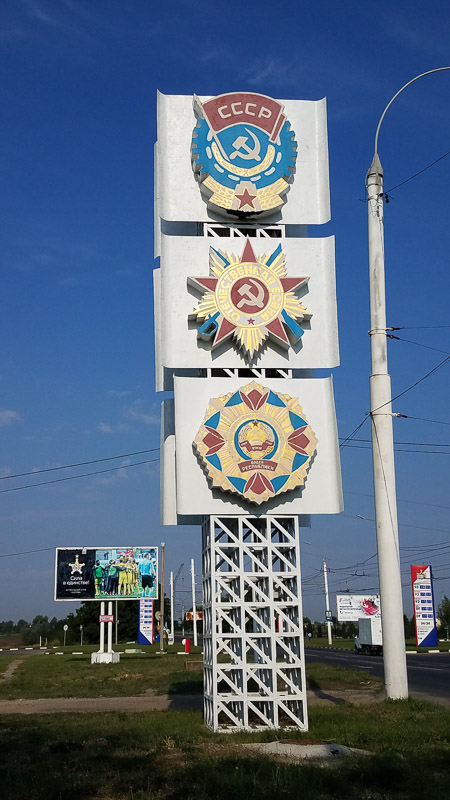
USSR still lives on in Transnistria. After the break up of USSR, people of this region (officially belonging to Moldavia at the time) did not want communism to end. From what I saw riding through, they seem to made communism work.

One of several underground wine cellars outside Kishinev, Moldavia. Moldavia has largest underground tunnel system used for wine storage in the world.
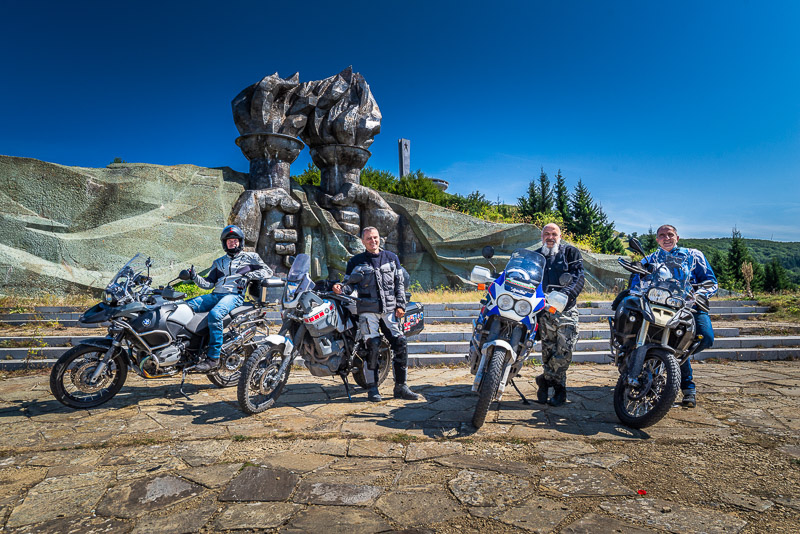
End of the trip with Bulgarian riders that I met on the Caspian sea ferry, 20,000 km earlier.

No visit to Bulgaria is complete without taking a photo at the spaceship Enterprise.
In numbers:
Favorite roads:
Favorite stays:
My other adventure rides: